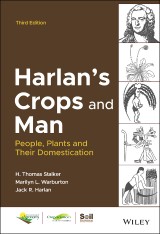Details

Harlan's Crops and Man
People, Plants and Their DomesticationASA, CSSA, and SSSA Books 3. Aufl.
|
44,99 € |
|
| Verlag: | Acsess |
| Format: | |
| Veröffentl.: | 26.03.2021 |
| ISBN/EAN: | 9780891186359 |
| Sprache: | englisch |
| Anzahl Seiten: | 320 |
DRM-geschütztes eBook, Sie benötigen z.B. Adobe Digital Editions und eine Adobe ID zum Lesen.
Beschreibungen
<p><b>A scientific and historical study of crops and their age-old relationship with human civilization</b></p> <p>The cultivation and harvesting of crops have been at the heart of human culture and development for thousands of years. As we have grown from hunter-gatherers into agrarian societies and industrial economies, our ongoing relationship with the plants that feed us and support our manufacturing has also evolved. So too, of course, have those plants themselves, with the combined forces of shifting climates, selective plant breeding, and genetic modification all working to alter their existence in profound and fascinating ways.</p> <p>Coming some 30 years after its previous incarnation, the third edition of <i>Harlan’s Crops and Man</i> marks an exciting re-examination of this rich topic. Its chapters lay out the foundations of crop diversity as we know it, covering topics that range from taxonomy and domestication to the origins of agricultural practices and their possible futures. Highlights include:</p> <ul> <li>Archeological and anthropological studies of agriculture’s history and development</li> <li>Detailed examinations of the histories and classifications of both crops and weeds</li> <li>Explanations of taxonomic systems, gene pools, and plant evolution</li> <li>Studies of specific crops by geographical region</li> </ul> <p> </p> <p>Updated to include the latest data and research available, this new edition of <i>Harlan’s Crops and Man</i> offers an illuminating exploration of agricultural history to all those engaged with plant science and the cultivation of crops.</p>
<p>Preface viii</p> <p><b>1 Prologue</b><b><i>: </i>The Golden Age 1</b></p> <p>Crop Evolution 2</p> <p>The Hunter-Gatherer Stereotype 3</p> <p>What Do Gatherers Eat? 11</p> <p>Understanding Life Cycles of Plants 20</p> <p>General Botanical Knowledge 23</p> <p>Manipulation of Vegatation 25</p> <p>Food Plants in Ritual and Ceremony 26</p> <p>On Sharing the Bounty 27</p> <p>Population Control and the Aged 29</p> <p>Conclusions 30</p> <p>References 31</p> <p><b>2 Views on Agricultural Origins </b><b>37</b></p> <p>Agriculture as Divine Gift 37</p> <p>Domestication for Religious Reasons 43</p> <p>Domestication by Crowding 45</p> <p>Agriculture as Discovery 46</p> <p>Agriculture by Stress 49</p> <p>Agriculture as an Extension of Gathering 50</p> <p>Domestication by Perception 53</p> <p>A No-Model Model 56</p> <p>Geography of Plant Domestication 59</p> <p>An Ecological Approach 63</p> <p>Conclusions 73</p> <p>References 73</p> <p><b>3 What Is a Crop? </b><b>79</b></p> <p>Definitions 80</p> <p>Intermediate States 81</p> <p>A Short List of Cultivated Plants 86</p> <p>Crops That Feed the World 106</p> <p>References 107</p> <p><b>4 What Is a Weed? </b><b>109</b></p> <p>Definitions 110</p> <p>Intermediate States 113</p> <p>Crop–Weed Complexes 116</p> <p>Some Weed Adaptations 120</p> <p>Weeds and History 122</p> <p>Conclusions 127</p> <p>References 127</p> <p><b>5 Classification of Cultivated Plants </b><b>131</b></p> <p>Botanical Descriptions and Names 132</p> <p>Problems of Formal Taxonomy 134</p> <p>The Gene Pool System 136</p> <p>Evolutionary Implications 143</p> <p>Conclusions 145</p> <p>References 145</p> <p><b>6 The Dynamics of Domestication </b><b>147</b></p> <p>Domestication of Seed Crops 147</p> <p>Domestication of Vegetatively Reproduced Crops 163</p> <p>Conclusions 167</p> <p>References 167</p> <p><b>7 Space, Time, and Variation </b><b>171</b></p> <p>Kinds of Patterns of Variation 171</p> <p>Noncentric Crops 175</p> <p>Diffuse Origins 178</p> <p>Microcenters 180</p> <p>Landrace Populations 181</p> <p>Implications for Plant Breeding 183</p> <p>Conclusions 190</p> <p>References 190</p> <p><b>8 The Near East </b><b>195</b></p> <p>Introduction 196</p> <p>Archaeological Prelude 200</p> <p>A Note About Dating Archaeological Sites 202</p> <p>Archaeological Sequence of Village Sites 204</p> <p>Spread of Agriculture Out of the Nuclear Area 210</p> <p>Recorded History 211<i>`</i></p> <p>Conclusions 212</p> <p>References 213</p> <p><b>9 Indigenous African Agriculture </b><b>216</b></p> <p>Introduction 217</p> <p>Archaeological Prelude 217</p> <p>A Savanna Complex 223</p> <p>Crop Competition and Distribution 227</p> <p>Recorded History 228</p> <p>Décrue Agriculture 230</p> <p>Conclusions 232</p> <p>References 233</p> <p><b>10 The Far East </b><b>236</b></p> <p>Archaeological Prelude 237</p> <p>Recorded History 240</p> <p>Far Eastern Crops 241</p> <p>Hunter-Gatherers of Japan 257</p> <p>Plant Domestication in India 258</p> <p>Conclusions 259</p> <p>References 259</p> <p><b>11 The Americas </b><b>263</b></p> <p>Archaeology 263</p> <p>The Crops 269</p> <p>Indigenous Americans as Biochemists 283</p> <p>Conclusions 287</p> <p>References 288</p> <p><b>12 Epilogue: Who’s in Charge Here? </b><b>295</b></p> <p>References 302</p>
<p><b>H. Thomas Stalker,</b> Department of Crop and Soil Sciences, North Carolina State University, Raleigh, NC, USA</p><p><b>Marilyn L. Warburton,</b> USDA ARS Corn Host Plant Resistance Research Unit, Mississippi State University, MS, USA</p><p><b>Jack R. Harlan </b>[deceased], Department of Agronomy, University of Illinois, Urbana, IL, USA</p>
<p><b>A scientific and historical study of crops and their age-old relationship with human civilization</b></p><p>The cultivation and harvesting of crops have been at the heart of human culture and development for thousands of years. As we have grown from hunter-gatherers into agrarian societies and industrial economies, our ongoing relationship with the plants that feed us and support our manufacturing has also evolved. So too, of course, have those plants themselves, with the combined forces of shifting climates, selective plant breeding, and genetic modification all working to alter their existence in profound and fascinating ways.</p><p>Coming some 30 years after its previous incarnation, the third edition of <i>Harlan’s Crops and Man</i> marks an exciting re-examination of this rich topic. Its chapters lay out the foundations of crop diversity as we know it, covering topics that range from taxonomy and domestication to the origins of agricultural practices and their possible futures. Highlights include:<ui><li>Archeological and anthropological studies of agriculture’s history and development</li><li>Detailed examinations of the histories and classifications of both crops and weeds</li><li>Explanations of taxonomic systems, gene pools, and plant evolution</li><li>Studies of specific crops by geographical region</li></ul><p>Updated to include the latest data and research available, this new edition of <i>Harlan’s Crops and Man</i> offers an illuminating exploration of agricultural history to all those engaged with plant science and the cultivation of crops.</p>


















